Installation Guide for Finishline Fencing 4mm
About Finishline
Thank you for choosing Finishline Fencing for the containment of your horses and/or livestock! We are confident that you will be satisfied like the thousands of others who are using Finishline on their farms worldwide. Finishline has 45 years of tested durability and strength, while delivering a beautiful fence that will add value to your property.
Finishline is as strong as a wire fence with 1,250 lbs. of tensile strength per strand. It is the only product of its kind to be manufactured with vital UV inhibitors throughout. This UV protection maintains the products strength, flexibility, and stunning appearance. Finishline is lightweight and easy to install. A 2,000-foot spool of Finishline weighs only 23 lbs. and has a silk like feel that can be hand tensioned by applying 150 lbs. of pull. This simple installation is a do-it- yourselfers dream!
Finishline can withstand temperatures from -40 to 128 degrees Fahrenheit without losing its tension. No more wasted time maintaining the proper tension and viability of your fences.
Finishline contains no wire, which delivers several great advantages; it is lightweight thus easy to install, requires no special equipment for installation and in some cases can be tensioned by hand. Finishline flexes upon harsh impact from horses and livestock which can reduce the risk of injury.
As all horse/livestock owners know, no containment system is fool proof. We recommend the use of an electric line with all Finishline installations. Please continue to look through our installation guide so you can properly install your Finishline and know that your livestock will be safely contained behind the best!
Pre-Installation
The prerequisite to a successful Finishline Fence Installation is advanced planning, combined with proper tools and quality materials. Before you begin, walk the proposed layout to check for any obstructions that might cause you to have to modify your layout. Modifying your layout is easier in the planning stage than in the middle of installation.
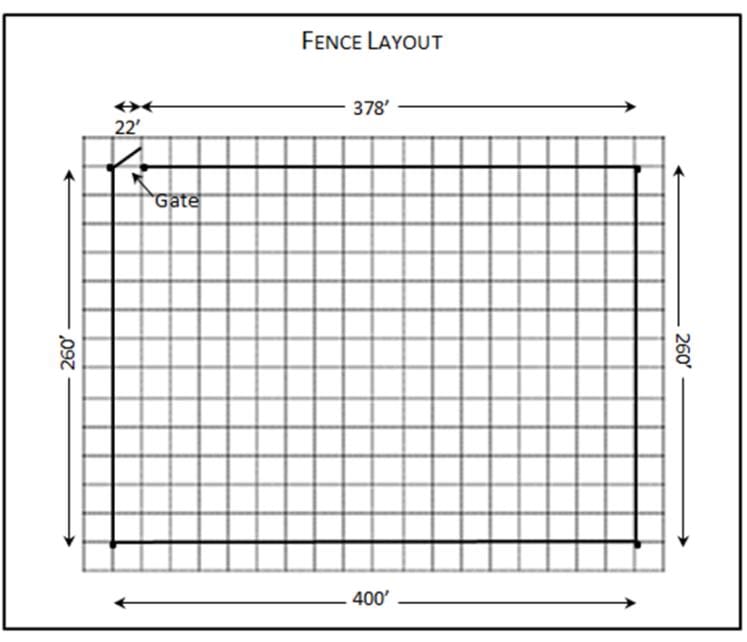
When you feel confident that your proposed layout will work, draw a measured, or to scale, layout of your fence installation. This fence layout will be a valuable planning aid and will also help establish a materials list. Please see Illustration 1.1 to the left.
Note that the space between posts and the number of strands installed is determined by the intended use of the enclosure; pasture, feed lot, corral, etc. and what type of animals and how many animals will be enclosed.
When you have completed your fence layout, contact your local utility company and schedule an inspection to determine if and where utility lines are located. Typically, in most localities, a free “One Call” program is available, and response is in less than three days. THIS IS VITAL BEFORE DIGGING THE FIRST POST HOLE OR DRIVING THE FIRST POST.
Following all safety requirements and guidelines is as important as any component of your plan. This includes, but is not limited to; eye protection, gloves, and steel toed work boots. Also, use ear protection when operating power augers or post drivers.
Recommended Number of Strands and Spacing
When installing Finishline Fencing, acceptable post spacing is 8 to 12 feet apart. Finishline recommends using at least one strand of electric when installing your fence line. If you choose not to use electric, please do so with caution. Size of the herd, types of animals being contained, animal personalities, and beauty will influence the numbers of strands needed to contain your animals. Please see Electrifying the Fence on page 5 for more details.
Equine/Donkey- Horse owners for years have used Finishline for safe containment of their horses. When containing horses, it is recommended to use 4 to 5 strands of Finishline Fencing and to space them 7 to 12 inches apart. The top strand should be a minimum of 52 to 54 inches from the ground and 2 to 4 inches from the top of the post. The bottom strand is typically 14 to 18 inches off the ground. Horses which have a tendency to rub fencing continually or "play" with fencing can lead to problems for the fence and the horse. In cases of frequent horse contact with fencing, the electric line should help train animals off the fence. Please see Illustration 2.1 for installation ideas.
NOTE- For foals you’ll need to install another lower strand of electric for safety and training purposes. Stallions and Jumpers- For extra fence height, use 6 to 7 strands of Finishline Fencing.
Cattle- Use 3 lines of Finishline with two lines of barbed or electric between strands. Finishline is an excellent sight line for large cattle farms. Please see Illustration 2.1 above for an example.
Other Livestock- For use with other animals such as goats, sheep and minis, place Finishline closer together for optimum containment and use 2 to 3 strands of electric.
Deer- Finishline is an excellent option when your property has problematic deer. Higher installation and closer spacing helps to protect your land from being intruded on by deer. In most cases deer are reported to bounce off the fence without breaking it or clears the Finishline fence line with minimal damage.
Please Note:
The above examples are suggestions only.
Fencing of all livestock comes with risk. Please use your own judgement and research for your final installation. It is our recommendation to use electric with all Finishline installations to provide the safest containment system. If you choose not to use electric, please do so with caution.

Attaching Finishline to your Posts
Finishline can be used with any type of post system. The two most common types are wood posts and t-posts. See below for the different ways to attach Finishline to your wood and t-posts.
Wood Posts - There are four main options to attach Finishline Fence to wood posts: wood post insulators, ring insulators, drilling, and stapling. Use a template to mark locations for your post attachment placement.
1- Wood post insulators
To use wood post insulators, simply attach to wood post with galvanized roofing nails. Once attached to the posts, run the Finishline through the holes to keep it aligned.
2- Ring insulators
To install ring insulators use a Ring Insulator Drill Tool and attach to your drill. A pilot hole may be needed depending on your post.
3- Drilling through the posts
Finishline Fencing can be installed by drilling through line posts and running the Finishline Fencing through holes up to the end post where it will be anchored. If drilling is selected, determine the line spacing. Helpful Hint- Determine top and bottom height and divide that space by number of strands you are installing. After marking your posts by measuring or using a wooden template such as a 2x4 with holes pre-drilled at the selected spacing you’re ready to start drilling. Using a template will allow fast hole alignment and allows the fence to follow the contours of the land.
To drill holes, use a battery-operated or portable generator-operated electric drill with a 1/4-inch wood drill bit. For large diameter posts, a 1/4-inch bell hanger installer drill bit permits drilling through the thickest posts.
NOTE: The use of through-the-post installation carries with it a slight risk of abrasion. If this is a concern, you may line the holes with protective tubing. Abrasion can be reduced by using an electrified wire with Finishline Fencing, as this will help prevent animals from pushing on the
fence.
4- Staples (Insulated or standard U)
When installing with the Staples, care should be taken to prevent crushing Finishline. Using insulated staples will prevent this from happening and permits Finishline to slide freely without wear.
Please see Illustration 3.1 for an example.

T-Posts – We carry multiple accessories that be used with T-Posts. Three that will attach Finishline to the post and two toppers to help protect the top of the metal post.
1- Standard & Heavy-Duty T-Post Insulators
Available in white or black. 25 to a bag.
2- LockJawz
Provide added flexibility when placing the insulator to the T-Post. Can be attached at any angle. Available in white or black. 25 to a bag.
3- T-Post Vinyl Safety Cap
Lightweight and helps to provide more visibility and a layer of protection from the metal post. Available in white. 25 to a bag.
4- T-Post Safety Topper
Larger molded topper which provides added visibility and the ability to hold electric line and has a higher layer of protection from the metal post. Available in white or black. 10 to a bag.
Installing Your Finishline
Start Post
The four most common ways to begin and/or end your Finishline runs are as follows:
1- Finishline Bayco Knot
Give yourself approximately 3 feet of Finishline to start the knot. Wrap around your start post 3 times, wrap the short end up the run line 3 times then wrap back 3 times. Once you do this, insert and wrap the Finishline around the original loop 2-3 times to secure the line. Please see Illustration 4.1.

2- Sure Stop – 1 1/8-inch hole
To start your fencing with a Sure Stop you’ll need to drill a 1/4-inch hole through your entire start post. Then use a 1 1/8-inch drill bit on the outside of the post where you will insert the Sure Stop and drill a hole that is ½-inch deep.
Begin by threading the Finishline back through the hole while holding the narrower end of the Sure Stop at the first post. Insert the line through the Sure Stop then insert the Sure Stop into the post. Always cut Finishline at an angle when using a Sure Stop for easier insertion. See Illustration 5.1 to see how the Sure Stop looks installed.
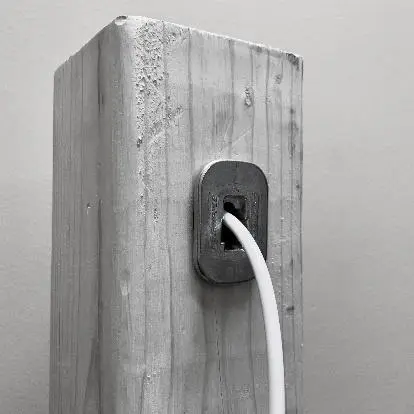
3- One-Way Vice – 5/8-inch hole
To start your fencing with a One-Way Vice you’ll need to drill a 1/4-inch hole through your entire start post. Then use a 5/8- inch drill bit on the outside of the post where you will insert the Vice.
Begin by threading the Finishline back through the hole while holding the pointed end of the vice at the first post. Insert the line through the vice then insert the vice into the post. Always cut Finishline at an angle when using a vice for easier insertion. Please see Illustration 5.2 for diagrams on how to tension.
NOTE: It is not necessary to secure the vice to the post.

4- GP No. 2 (GP2)– 1/4-inch hole
When using a GP2, installation is very similar to the One-Way Vice. Drill through your end post with a 1/4-inch drill bit. Begin by threading the Finishline back through the hole and insert the line into the GP2. The GP2 will hold tension on the outside of your post. You then have the option to tack Finishline to your post with a staple, or loop back into GP2. This will allow Finishline to be re- tensioned if needed. Cut Finishline at an angle when using a GP2 for easier line insertion. See Illustration 5.3 to see how GP2 looks installed.
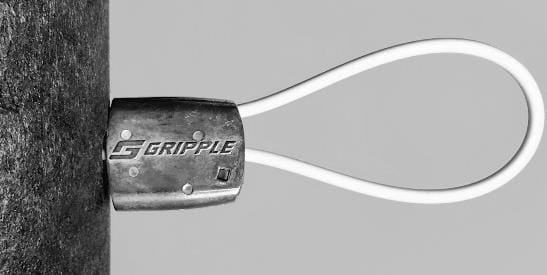
Please note:
When meeting at a corner with two End Stops, slightly offset the holes so they do not cross inside of the post.
Stretching for Proper Tension at Your End Post
A Sure Stop, One-Way Vice or GP2 is inserted into at least one end post and optimally both for each strand of Finishline that is being installed. Thread the Finishline through the end stop and pull all slack from the fence run. Once this is done, it is time to tension your fence.
Pull Finishline Fencing from both ends, for proper tension, unless starting with a Finishline Bayco Knot where this would be impossible. Always start at the bottom strand and work your way up to the top strand. Always be sure to leave enough extra fence (6-10 inches) on both ends to attach a strand stretcher or vice grips. On shorter runs, Finishline can be tensioned by hand. Please see Illustration 6.1 for tips on tensioning your Finishline Fence. Keep in mind colder weather does make tensioning more difficult. A Torq Tensioning Tool will make tensioning easier.
Mark line at 3% with marker and
pull until line comes through vice

Finishline Fencing requires a tension of 3-4% of total strand length. For example, a 400-foot length with a 3% tension is 12 feet (.03 X 400). As a result, you would need to tension your fence twelve feet.
After determining the length needed to tension the fence, measure in from the end post to the predetermined length and mark the fence line with a marker or ribbon. Begin stretching with Torq Tensioner Tool, hand strength, or other fence stretchers. Using a mark on the fence or ribbon will help ensure proper tension is being applied. After tension is reached, cut all but approximately one foot of your fence line. Tack extra Finishline with a staple to the post for future tensioning needs.
Splicing/Repairing- If your job requires more than one spool of Finishline, it will be necessary to splice the spools together. This is also the way you would repair breaks in the Finishline. This can be done with a Wire Link or Gripple.
To use a Wire Link, put both ends of the line that you are splicing into opposing holes at the end of each Wire Link. Always cut Finishline at an angle for easier insertion. Please see Illustration 6.2 of the Wire Link in use. To use a Gripple, follow arrows on the Gripple putting one strand in the top holes and the other strand through the bottom.

Electrifying the Fence
Only a livestock owner can determine what is best for his/her animals with regards to how much electric current is needed for safe containment. Finishline Fencing cannot carry an electrical charge itself, but a Finishline Fence can be electrified in several ways. We have listed below some common installation techniques.
1- Attach a strand of electric on the inside portion of your posts using an insulator.
2- Reduce your Finishline strands by one and install an electric line in its place.
3- Wrap an electric line around one of your Finishline strands. Using this technique will reduce the amount of labor necessary to upkeep electric. Because Finishline rarely loses tension, you can support your electric line by wrapping it around one of your Finishline strands. This will eliminate the need for you to re- tension your electric strands. A 16-gauge aluminum wire can be easily wrapped several times around a Finishline strand between posts. The electric wire will need to go through an insulator on each post. Finishline acts as an insulator and will not short your line. Please see Illustration 7.1 for example.
The inclusion of electric is recommended for all Finishline Fencing installations.
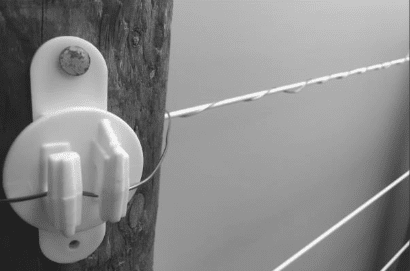
Calculating the Number of End Stops
In Illustration 7.2, there are only 4 end posts where the Finishline is being terminated and tensioned. These are marked by the word “Vice”. In the example provided, this person was using 5 strands of Finishline. To determine the number of End Stops required, multiply the number of posts where you are terminating by the number of Finishline strands you are installing, and this will tell you how many End Stops to purchase. In this case, this person needs to purchase 20 Sure Stops, One-Way Vices or GP2s.

When runs are over 150ft. it is advisable to use End Stops at both the start and end of each run. In Illustration 7.2 the knots would be replaced by End Stops. In the example above, 40 Sure Stops, Vices or GP2s would be needed.
In Illustration 8.1, there are 5 end posts where the Finishline is being terminated and tensioned. In this example, this person was using 3 strands of Finishline. To determine the number of End Stops required, multiply the number of posts where you are terminating by the number of strands you are installing. This will tell you the number of End Stops to purchase. In this case, this person needs to purchase 15 Sure Stops, One-Way Anchor Vices or GP2s.
As previously mentioned, when runs are over 150ft. it is advisable to use an End Stop at both the start and end of each run. In Illustration 8.1 the knots would be replaced by End Stops. In this example, 30 Sure Stops, Vices, or GP2s would be needed.
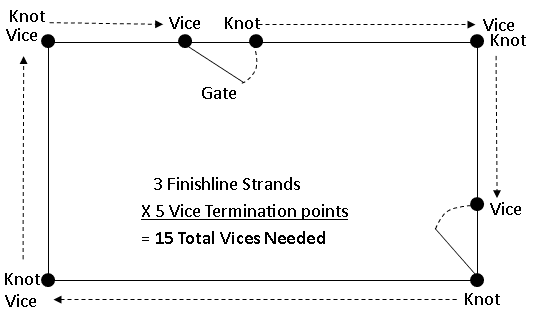
Please Note:
If you need help or advice determining the amount and type of accessories to use, please contact a Finishline advisor. By providing a simple sketch with the length of your runs and approximate location of gates we can quickly provide you with the most optimal and cost-effective plan. (724) 625-6100 / info@agliner.com
Additional Information
With time, Finishline Fencing may loosen due to movement of fence posts. Fencing should be checked occasionally. If fence can be pulled towards you easily, it is recommended to tighten the fence by pulling at the used End Stop. If loss of tension is due to loose posts, it is important to locate the loose post and correct.
Helpful hint: If your gate or a start post is less than 100 ft away from the next corner, feel free to wrap around the outside of the post and tension at the next gate or end post. This will save on the number of End Stops needed. It is recommended to put some sort of protective covering around the Finishline ence to eliminate abrasion such as a Corner Collar Insulator. Common household items also work well for this such as an old garden hose. Please see Illustration 8.3 for example.
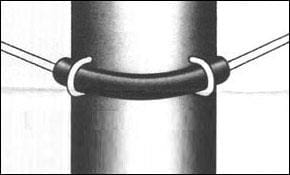
Measuring Guide
Wondering how much Finishline to buy? Use the chart provided to determine the number of spools required for your fencing project.
Finishline is available in 2,000ft spools
Please use the grid below to sketch your fence layout.
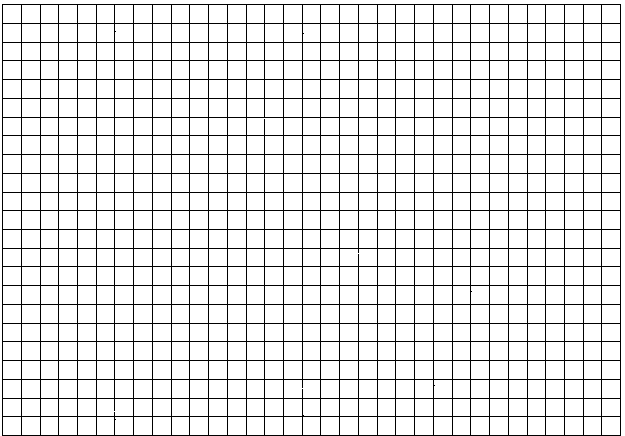
Although the informaton and recommendations in this Finishline Fencing Installation Guide is presented in good faith and believed to be correct, Ag-Liner, Inc. makes no representations or warranties as to the completeness or accuracy of the information.
Information and product is supplied upon the condition that the persons receiving same will make their own determinating as to its suitability for their purposes prior to use. In no event will Ag-Liner, Inc. be responsible for damages of any nature whatsoever resulting from the use of our products or reliance upon this information.
If you have any questions, or would like to order:
please call us Toll Free at (877) 625-6100 or (724) 625-6100
Or order online at FinishlineFence.com
